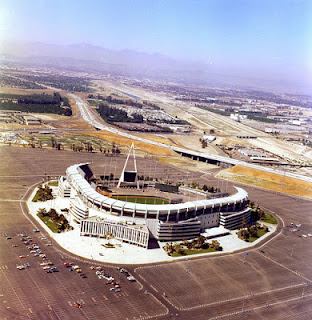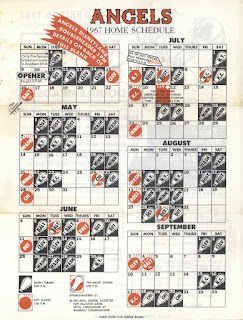I've yet to venture into Orange County on this blog, so my first venture across county lines is going to be about baseball and a whole lot more. It's probably not surprising that Orange County was once a part of Los Angeles County, divided off in 1889. The 213 area code used to stretch all the way to the Mexican border, until a flash cut in 1951 created the 714 for Orange and San Diego Counties.
Philadelphia Athletics in Anaheim for Spring Training
Los Angeles had Wrigley Field (1925) and Gilmore Field (1939), and not only did these facilites house Pacific Coast League teams, but they hosted Spring Training for major league teams. The Chicago Cubs and New York Giants both spent Spring Training time in Los Angeles, with the Cubs building a permanent facility on Catalina.
At the same time Gilmore Field was opening, Anaheim opened it's first baseball stadium: La Palma Park Stadium. At the intersection of Harbor and La Palma ave, the stadium was built to house Anaheim's entry in the newly founded California League.
There had been several attempts to start a California league since the turn of the century. The California State League of 1899-1902 was affected by the National Agreement between the National and American Leagues. Six franchises, including the LA Angels, broke off to form the Pacific Coast League which fell under the National Agreement.
In 1941, the current California League was formed with franchises in Anaheim, Riverside, Bakersfield, and Santa Barbara to name a few. The Anaheim team was known as the Anaheim Aces and played at La Palma Park. It's a small park (it still stands), which held just 3504 spectators when it opened.
The Aces only lasted one year, but they weren't the only team to use the park. The Philadelphia Athletics held Spring Training there from 1940-42. You can see in the photo, they were a hit with the local ladies.
World War II forced the Athletics to not come back. Anaheim would try minor league baseball again in 1947 with the Anaheim Valencias, founding members of the short lived Class C Sunset League.
Anaheim Valencias, 1947
The Valencias were actually successful, winning the Sunset League title in 1947. Their uniforms are obviously inspired by the Philadelphia Athletics who had held Spring Training there, and the oranges on the shoulder should be a clue that they were named after the Valencia oranges grown locally. In fact, the California Valencia Orange Show (a bit of a trade show for orange growers) was held at the site of La Palma Park Stadium in 1931.
That's a lot of oranges! (Photo courtesy Orange County Historical Society)
The Valencia's battled the Riverside Dons and the Ontario Orioles for two years, before television broadcasts of Major League games hurt attendance at minor league ballparks nationwide. The Valencias folded after the 1948 season.
Professional organized baseball wouldn't return to Anaheim until 1965, but Anaheim would change forever in 1955. Walt Disney had been drawing Mickey Mouse shorts since 1928's Plane Crazy. In 1937 his first feature length cartoon Snow White premiered at the Carthay Circle Theater.
Disney didn't invent the idea of the large fair, New York and San Francisco held large expositions, nor did he invent the large park (Griffith Park and Central Park were certainly inspirations. What Disney did was have the wherewithal to combine the two concepts with giving fans of his films something to visit (studio tours of an animation studio lacking a bit of pizzaz) creating Disneyland which opened in 1955.
Disney bought 160 acres of orange groves and walnut trees in Anaheim, and spent $17 million on construction which took one year. The Santa Ana Freeway (then US 101, now I-5) was completed in 1956, linking Los Angeles with Disneyland directly. In fact, on this map (1958) the adress is listed as Santa Ana Freeway at Harbor Blvd. a sign of the changing (more suburban) nature of Los Angeles and Orange counties where address were relative to nearby freeways, instead of local cross streets.
That image and the upcoming images that inspired this triple entry (Orange County, Disneyland, and baseball) all come from Vintage Disneyland Tickets, a website I consider a must see for any LA history enthusiast.
Dodger Stadium broke ground in 1959 on 352 acres costing $23 million to build (privately financed). It was built off the Pasadena Freeway, just south of the junction with the Santa Ana Freeway. It opened in 1962 and while it was built by the Dodger owner Walter O'Malley for the Dodgers, it would open with two tenants.
The Dodgers moved to Los Angeles in 1958 after O'Malley purchased and moved the Los Angeles Angels. As the Brooklyn Dodgers, O'Malley sought a replacement for the aging Ebbets Field in Brooklyn. He wanted another site within the borough, but New York City official Robert Moses wanted to build the stadium in Queens on the site of a former World's Fair.
Moses was a big proponent of freeways, and with his public funds was responsible for the Triborough Bridge and was just generally always in favor of car culture over public transportation. O'Malley wanted nothing to do with Queens, and came out west for a new beginning. Moses would eventually build his stadium, Shea Stadium, which became the home of the New York Mets in 1964.
The New York Mets were an expansion franchise granted to the National League to replace the Dodgers and Giants who both left New York in 1958. They entered the league in 1962, paired with the Houston Colt 45s. The year before the American League had expanded, placing franchises in Washington and Los Angeles.
The Washington franchise was a replacement for the Senators who had left for Minnesota. The LA franchise was the American League keeping pace with the westward heading National League.
The Dodgers adopted the cap logo of the original LA Angeles, but the American League LA franchise owner Gene Autry paid the Dodgers to use the name. Since the original Angels had been moved elsewhere, the AL LA Angels moved into vacant Wrigley Field for the 1961 Season.
While the Dodgers were playing in a cavernous football stadium (the LA Coliseum), the Angels were playing in the majors' smallest ballpark. It was only 340 to left field, and the Angels pilled up an then franchise record 240 home runs.
When Dodger Stadium opened up in 1962, the LA Angels moved in though they called it Chavez Ravine. Gene Autry sought a stadium site in Los Angeles, even Long Beach. The City of Long Beach wanted them to be known as the Long Beach Angels, so that was nixed. The team ended up striking a deal with the City of Anaheim.
Anaheim Stadium 1977. The Orange Freeway in the background was finished in 1975.
In contrast with Dodger Stadium, it was the City of Anaheim that financed Anaheim Stadium. It was built on 160 acres (same size as Disneyland) at $24 million. Like Disneyland it was built off the Santa Ana Freeway (Orange Freeway wasn't completed yet. Note the original home plate gate before Disney renovated it, and the Big A in the outfield holding up the scoreboard instead of a marquee by the freeway. It opened in 1966, at which point the team became the California Angels, with an interlocking C-A instead of L-A in the original logo.
With all of that as background we get to the item which inspired today's post. In 1967, the California Angels' second year in Anaheim Stadium, a deal was offered where one could purchase tickets for a doubleheader. For the low price of $5.00 each, fans would get a ticket in the reserve level at Anaheim Stadium to watch the Angels take on the Cleveland Indians at 3:00pm on Saturday. They would then have access from 8pm to 1am to a special party at Disneyland Park.
The 3:00 start is interesting. In England, soccer matches traditionally started at 3:00 because that was just after the factories closed on Saturdays. At Disneyland patrons would have access to all attractions without the need for individual tickets. It really was quite the deal. And it represents the symbiotic marketing of the Angels and Disneyland which still happens today.
On the back is a complete Angels schedule. Night games (8:00 starts) are designated with light bulbs. You can see that day games usually start a 1:00pm, so the doubleheader start time was a special deal. There was also a twinight start with first pitch at 6:00. Now most every MLB game starts at 7:00pm.
Anaheim Stadium from the inside, 1966.
There are also a number of scheduled doubleheaders. And look at that, Anaheim Stadium was granted the All Star Game in just it's second year of existence. The LA Coliseum would host the All-Star Game one year after the Dodgers moved to LA, but Dodger Stadium wouldn't host an All-Star game until 1980 (and hasn't since). Part of that is just a result of baseball's rapid expansion in this time period, meaning plenty of new stadiums to work into the rotation (and revisiting some classics) not to mention the rise of the NFL leading to multipurpose stadiums being built in many cities.
So there you have it, a brief history of baseball in Anaheim and Disneyland Park, and how it all came together in 1967.
*Updated to correct dates, and to add photos of Anaheim Stadium.











